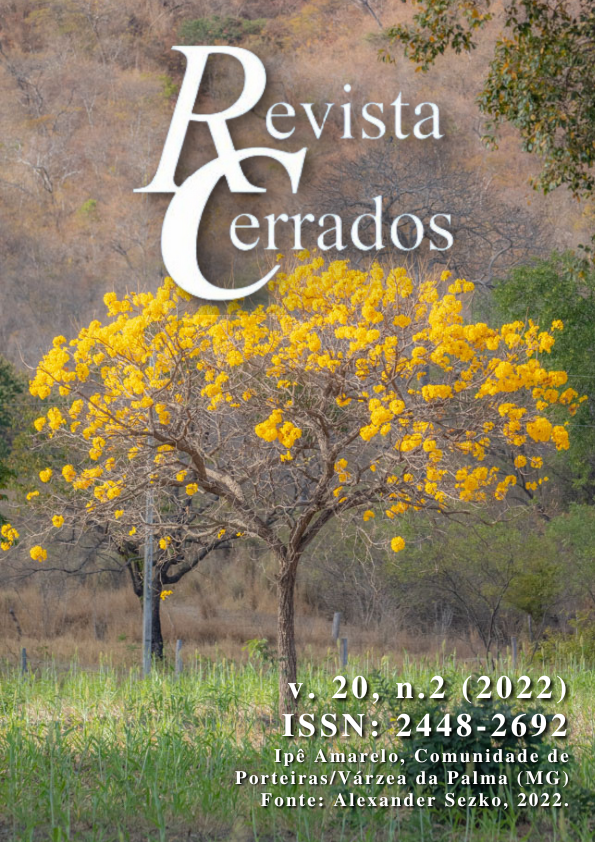Impacts of dry and frost period on vigor of vegetation: a case study for the Guariroba watershed, Campo Grande, Mato Grosso do Sul
DOI:
10.46551/rc24482692202225Keywords:
Climate changes; Dry; Frost; Orbital index; NDVI.Abstract
Dry periods occur in all regions, even in humid climates, due to climatic seasonality and the dynamism of the processes which generate rainfall. Meanwhile, anthropogenic climate change is impacting precipitation and temperature patterns, and some areas of the planet are experiencing changes in the frequency and severity of weather extremes such as heavy rains, droughts, cold and heat waves, forest fires and dust storms. The Guariroba watershed is a naturally fragile environment, highly susceptible to soil erosion, however current land management practices do not take into consideration agricultural restrictions and skills. Given a context of climatic change, which constitutes a powerful stressor for ecosystems and biodiversity, this work analyzes the response of vegetation to climatic indicators based on the Normalized Difference Vegetation Index. The radiometric vegetation indices were derived from Sentinel-2 images using the software SNAP 8.0 of the year 2021. The results obtained show that the vigour of the vegetation in the Midwest region reflects the annual cycle of climatic patterns and the characteristics of temperature and precipitation. However, for the year 2021, vegetation vigour was severely impacted in response to drought and frost. Although the rainy season has started in the region and the vegetation responds to the first rains by regrowth and emergence, in the context of environmental degradation in the area and anthropogenic climate change, the 2021 scenario tends to be repeated and worsen in the coming years.
Downloads
References
ABBAS, S.; NICHOL, J. E.; FISCHER, G. A. Mapping and assessment of impacts of cold and frost on secondary forest in the marginally tropical landscape of Hong Kong. Agricultural and Forest Meteorology, [S./l.], v. 232, p. 543-549, 2017.
ALVARES, C. A. et al. Köppen’s climate classification map for Brazil. Meteorologische Zeitschrift, [S./l.], v. 22, n. 6, p. 711-728, 2014.
AWG. Anthropocene Working Group. Newsletter of the Anthropocene Working Group. 2020. Disponível em: http://quaternary.stratigraphy.org/wp-content/uploads/2021/03/AWG-Newsletter-2020-Vol-10.pdf. Acesso: 10 dez. 2021.
ATKINS, E. Contesting the ‘greening’ of hydropower in the Brazilian Amazon. Political Geography, [S./l.], v. 80, 102179, p. 1-10, 2020.
BRASIL. Lei Federal n. 9.985, de 18 de julho de 2000. Regulamenta o art. 225, § 1o, incisos I, II, III e VII da Constituição Federal, institui o Sistema Nacional de Unidades de Conservação da Natureza e dá outras providências. Disponível em: http://www.planalto.gov.br/ccivil_03/leis/l9985.htm. Acesso: 22 nov. 2021.
BRITO, B. et al. Stimulus for land grabbing and deforestation in the Brazilian Amazon. Environmental Research Letters, [S./l.], v. 14 064018, p. 1-8, 2019.
BRUM, E. Banzeiro Òkòtó: Uma viagem à Amazônia centro do mundo. São Paulo: Companhia das Letras, 2021.
CAPOANE, V. Classificação automatizada do relevo da bacia hidrográfica do córrego Guariroba, Campo Grande - MS. In: SANTOS, G. B.; FELIPPE, M. F.; MARQUES NETO, R. (Org.). XIII SINAGEO: Geomorfologia: complexidade e interescalaridade da paisagem. São José dos Campos: Comum Design, 2022, p. 2020-2030.
CAPOANE, V. Mapeamento dos pequenos reservatórios e análise dos impactos ambientais associados na bacia hidrográfica do córrego Guariroba, Campo Grande - MS. Geo UERJ, Rio de Janeiro, n. 39, e51688, p. 1-23, 2021.
CAPOANE, V. Implicações da resolução e fonte de modelos altimétricos na análise quantitativa de atributos geomorfométricos para bacia hidrográfica do córrego Guariroba, Campo Grande, MS. Revista Brasileira de Geografia Física, [S./l.], v. 13, p. 2417-2432, 2020.
CAPOANE, V. Susceptibilidade a erosão na bacia hidrográfica do córrego Guariroba, Campo Grande, Mato Grosso do Sul. Acta Brasiliensis, [S./l.], v. 3, n. 2, p. 49-55, 2019.
CAMPO GRANDE (Município). Decreto n. 7.183, de 21/09/1995. Campo Grande, 1995. Disponível em: http://www.campogrande.ms.gov.br/planurb/downloads/decreto-n-7-183-de-21-de-setembro-de-1995-institui-a-area-de-protecao-ambiental-dos-mananciais-do-corrego-guariroba-apa-do-guariroba/ . Acesso: 11 agos. 2019.
CAMPO GRANDE (Município). Plano de Manejo da Área de Proteção Ambiental dos Mananciais do Córrego Guariroba – APA do Guariroba. Campo Grande, 2008. Disponível em: http://www.campogrande.ms.gov.br/planurb/downloads/plano-de-manejo-da-area-de-protecao-ambiental-dos-mananciais-do-corrego-guariroba-apa-do-guariroba/. Acesso: 11 agos. 2021.
CAMPO GRANDE (Município). Plano de manejo Área de Proteção Ambiental dos Mananciais do Córrego Guariroba – APA do Guariroba – revisão. 2020. Portaria Planurb n.2, de 19 de março de 2021. Diogrande n.6.240, de 19 de março de 2021. Disponível em: http://www.campogrande.ms.gov.br/planurb/downloads/plano-de-manejo-area-de-protecao-ambiental-dos-mananciais-do-corrego-guariroba-apa-do-guariroba-1a-revisao/. Acesso: 11 jul. 2021.
CEMTEC. Centro de Monitoramento do Tempo e do Clima de MS. Banco de dados. Disponível em: https://www.cemtec.ms.gov.br/boletins-meteorologicos/ Acesso: 11 agos. 2021.
CEMADEN. Centro Nacional de Monitoramento e Alertas de Desastres Naturais. Situação atual e previsão hidrometeorológica para a bacia do rio Paraná. Disponível em: http://www2.cemaden.gov.br/wp-content/uploads/2021/06/NotaTecnica_BaciaParana_2021_Maio31.pdf. Acesso: 11 agos. 2021.
DU, Y. et al. Water bodies’ mapping from Sentinel-2 imagery with Modified Normalized Difference Water Index at 10-m spatial resolution produced by sharpening the SWIR band. Remote Sensing, [S./l.], v. 8, n. 4, p. 1-19, 2016.
ECCLES, R. et al. Impacts of climate change on streamflow and floodplain inundation in a coastal subtropical catchment. Advances in Water Resources, [S./l.], v. 147, 103825, p. 1-15, 2020.
ESA. European Space Agency. SENTINEL-2 User Handbook. Revision 2; ESA Standard Document; ESA: Paris, France, 2015.
FERRANTE, L.; FEARNSIDE, P. M. Brazil’s new president and ‘ruralists’ threaten Amazonia’s environment, traditional peoples and the global climate. Environmental Conservation, [S./l.], v. 46, p. 261-3, 2019.
HAMMER, O.; HARPER, D. A.; RYAN, P. D. PAST - Paleontological Statistics versão 4.0.3. 2021. Disponível: <http://www.folk.uio.no/ohammer/past>. Acesso: 10 fev. 2021.
ESA. European Spatial Agency. Sentinel Application Platform – SNAP Desktop implementation version 8. 2021. Disponível em: <http://step.esa.int/main/download/snapdownload/>. Acesso em: 11 jan 2021.
ESA. European Spatial Agency. Copernicus Open Access Hub. Disponível em: https://scihub.copernicus.eu/dhus/#/home. Acesso em: nov. 2021.
GESSESSE, A. A.; MELESSE, A. M. Temporal relationships between time series CHIRPS-rainfall estimation and eMODIS-NDVI satellite images in Amhara Region, Ethiopia. Extreme Hydrology and Climate Variability, p. 81-92, 2019.
HOEGH-GULDBERG, O. The Impact of Climate Change on Coral Reef Ecosystems. In: DUBINSKY, Z.; STAMBLER, N. (Org.). Coral Reefs: An Ecosystem in Transition, 2011. p. 391-403. https://www.researchgate.net/publication/226289185_The_Impact_of_Climate_Change_on_Coral_Reef_Ecosystems
HENDRICKS, D. M. Maps in Environmental Monitoring. In: ARTIOLA, J.F.; PEPPER, I. L; BRUSSEAU, M. L. (Org). Environmental Monitoring and Characterization, 2004. p. 69-84.
IBGE. Instituto Brasileiro de Geografia e Estatística. Estimativas da população residente no brasil e unidades da federação com data de referência em 1º de julho de 2020. Disponível em: https://ftp.ibge.gov.br/Estimativas_de_Populacao/Estimativas_2020/estimativa_dou_2020.pdf. Acesso: 22 nov. 2021.
INMET / SNM. Instituto Nacional de Meteorologia / Sistema Nacional De Meteorologia. Levantamento da onda de frio que atuou sobre o Brasil no final de julho de 2021. Disponível em: https://portal.inmet.gov.br/uploads/notastecnicas/LEVANTAMENTO_MASSA-DE-AR-FRIO-FINAL-DE-JULHO_vCGMADP.pdf#page=1&zoom=auto,-100,842. Acesso: 11 nov. 2021.
INPE. Instituto Nacional de Pesquisas Espaciais. Nota conjunta INMET / INPE / CENSIPAM. 2021. Disponível em: http://www.inpe.br/noticias/arquivos/pdf/NOTA_Emergencia_Hidrica_v05.pdf Acesso: 22 nov. 2021.
LYNAS, M.; HOULTON, B. Z.; PERRY, S. Greater than 99% consensus on human caused climate change in the peer-reviewed scientific literature. Environmental Research Letters, [S./l.], v. 16, n. 11, p. 1-8, 2021.
MapBiomas. Superfície de água no Brasil reduz 15% desde o início dos anos 90. Disponível em: https://mapbiomas.org/superficie-de-agua-no-brasil-reduz-15-desde-o-inicio-dos-anos-90. Acesso: 19 nov. 2021.
MARENGO, J. A. et al. Increased climate pressure on the agricultural frontier in the Eastern Amazonia–Cerrado transition zone. Scientifc Reports, [S./l.], v. 12, n. 457, p. 1-10, 2022.
MOTTA, P. E. F. da et al. Levantamento de reconhecimento de baixa intensidade dos solos do Município de Campo Grande, MS. Rio de Janeiro: Embrapa Solos, 2013.
NOBRE, A. D. O futuro climático da Amazônia: relatório de avaliação científica. São José dos Campos, SP: ARA: CCST-INPE: INPA, 2014.
OLIVEIRA, A. K. et al. Avaliação multitemporal das paisagens da Área De Proteção Ambiental (APA) dos mananciais do córrego Guariroba, Campo Grande, Mato Grosso do Sul, por meio de imagens de satélites. Ra’e Ga, Curitiba, v. 42, p. 8-20, 2017.
REYDON, B. P.; FERNANDES, V. B.; TELLES, T. S. Land governance as a precondition for decreasing deforestation in the Brazilian Amazon. Land Use Policy, [S./l.], v. 94, p. 1-13, 2020.
REYER, C. P. O. et al. Climate change impacts in Latin America and the Caribbean and their implications for development. Regional Environmental Change, [S./l.], v. 17, p. 1601-1621, 2017. DOI 10.1007/s10113-015-0854-6
RIBEIRO, J. F.; WALTER, B. M. T. As Principais Fitofisionomias do Bioma Cerrado. In: SANO, S. M.; ALMEIDA, S. P. de (Ed.). Cerrado: ambiente e flora. Embrapa Cerrados. – Brasília, DF: Embrapa Informação Tecnológica, 2008. P. 151-212.
ROCHEDO, P. R. et al. The threat of political bargaining to climate mitigation in Brazil Nature Climate Change, [S./l.], v. 8, p. 695-8, 2018.
ROSA, R. Introdução ao Sensoriamento Remoto. 7. ed. Uberlândia: EDUFU, 2009.
SANO, E. E. et al. Cerrado ecoregions: A spatial framework to assess and prioritize Brazilian savanna environmental diversity for conservation. Journal of Environmental Management, [S./l.], v. 232, p. 818-828, 2019.
SONTER, L. J. et al. Mining drives extensive deforestation in the Brazilian Amazon. Nature Communications, [S./l], v. 8, p. 1–7, 2017.
SPAROVEK, G. et al. Who owns Brazilian lands? Land Use Policy, [S./l.], v. 87, 104062, p. 1-3, 2019.
TRANCOSO, R. Changing Amazon deforestation patterns: Urgent need to restore command and control policies and market interventions. Environmental Research Letters, [S./l.], v. 16, n. 4,p. 1-6, 2021.
VILELA, T. et al. A better Amazon road network for people and the environment. A better Amazon road network for people and the environment. Proceedings of the National Academy of Sciences, [S./l.], v. 117, n. 113, 7095-7102, 2020.
WWF EU. World Wide Fund for Nature Europe. Fires, forests and the future: a crisis raging out of control? 2020. Disponível em: https://wwfeu.awsassets.panda.org/downloads/wwf_fires_forests_and_the_future_report.pdf. Acesso: 05 dez. 2021.
ZHONG, K. et al. Dynamic changes in temperature extremes and their association with atmospheric circulation patterns in the Songhua River Basin, China. Atmospheric Research, [S./l.], v. 190, p. 77-88, 2017.
Published
How to Cite
License
Copyright (c) 2022 Revista Cerrados

This work is licensed under a Creative Commons Attribution-NonCommercial-NoDerivatives 4.0 International License.
In this journal, the copyrights for published articles belong to the author (s), with the rights of the first publication belonging to Revista Cerrados. The articles are publicly accessible, free to use, their own assignments, educational assignments and non-commercial applications.


















